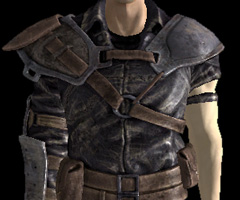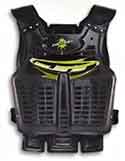m (Created page with 'Personal armor refers to articles of clothing that are designed to stop bullets, laser blasts, or other dangerous attacks and environments the wearer might need to prepare for. T…') |
(→Kevlar Armor) |
||
| (One intermediate revision by the same user not shown) | |||
| Line 6: | Line 6: | ||
==Types of Armor== | ==Types of Armor== | ||
| + | ===[[Leather Armor]]=== | ||
| + | [[image:Armor-LeatherHeader.jpg]] | ||
| − | + | [[image:Armor-Jacket.jpg|alt=A worn leather jacket with a metal plate over one shoulder.|Modern leather jackets are often worn to protect against low grade weaponry.|thumb|right]] | |
| − | + | ||
| − | [[image:Armor-Jacket.jpg|alt=A worn leather jacket with a metal plate over one shoulder.|Modern leather jackets are often worn to protect against low grade weaponry.|thumb| | + | |
Leather Armor is a weak type of body armor designed to protect the wearer from slow moving low caliber projectiles and a minimal amount of thermal energy as well as a full range of melee weapons. Though leather might usually only stop stray shrapnel or thrown weaponry, it has been known to protect against bullets in lucky scenarios. Often however, leather fabric is not intended to protect against thermal heat; some old pieces may even catch fire. | Leather Armor is a weak type of body armor designed to protect the wearer from slow moving low caliber projectiles and a minimal amount of thermal energy as well as a full range of melee weapons. Though leather might usually only stop stray shrapnel or thrown weaponry, it has been known to protect against bullets in lucky scenarios. Often however, leather fabric is not intended to protect against thermal heat; some old pieces may even catch fire. | ||
| Line 29: | Line 29: | ||
===Kevlar Armor=== | ===Kevlar Armor=== | ||
| + | [[image:Armor-KevlarHeader.jpg]] | ||
| + | |||
The kevlar vest is the military's answer to the slugthrower. It is made of tough, dense aramid fiber interwoven between plates of nylon and ceramic fabric. The carrier is usually insulated foam designed for further protection against stab strikes. It does not melt. | The kevlar vest is the military's answer to the slugthrower. It is made of tough, dense aramid fiber interwoven between plates of nylon and ceramic fabric. The carrier is usually insulated foam designed for further protection against stab strikes. It does not melt. | ||
Most kevlar vests certify level III in ballistic and level II in energy and energy; it is generally viewed as the all-around personal protection choice in any hostile situation. Although it is classified as "soft" armor, it affords minimal flexibility because of its keen design: the multiple layers and interlaced fabrics. To maximize scope, the kevlar vest may be worn with reinforced shoulder, knee, and groin protection made of the same material as the vest. These accessories add expense, however. | Most kevlar vests certify level III in ballistic and level II in energy and energy; it is generally viewed as the all-around personal protection choice in any hostile situation. Although it is classified as "soft" armor, it affords minimal flexibility because of its keen design: the multiple layers and interlaced fabrics. To maximize scope, the kevlar vest may be worn with reinforced shoulder, knee, and groin protection made of the same material as the vest. These accessories add expense, however. | ||
| − | Kevlar was originally the name of the fabric given by its inventor, DuPont Industries of Kevlar, but has since been expanded to include any protection device that uses the effective fiber-fabric layering. | + | Kevlar was originally the name of the fabric given by its inventor, DuPont Industries of Kevlar, but has since been expanded to include any protection device that uses the effective fiber-fabric layering. |
===Flak Armor=== | ===Flak Armor=== | ||
Latest revision as of 11:11, 1 July 2011
Personal armor refers to articles of clothing that are designed to stop bullets, laser blasts, or other dangerous attacks and environments the wearer might need to prepare for. There are many different kinds of armor, from a weak compressed leather vest to full-strength combat armor.
Protection of soldiers in the battlefield, a term known as survivability, is a tantamount priority to statesmen and generals. Regardless of technological strides and innovation, the heart of any weapon system is the soldier. Unfortunately, he is also the weakest chain.
Personal armor can be seen in almost every race in both the Hiverspace and Normalspace and seeks to improve the soldier's survivability by shielding him from the damaging elements. There are varying degrees of armor protection and different types of armor.
Contents
Types of Armor
Leather Armor
Leather Armor is a weak type of body armor designed to protect the wearer from slow moving low caliber projectiles and a minimal amount of thermal energy as well as a full range of melee weapons. Though leather might usually only stop stray shrapnel or thrown weaponry, it has been known to protect against bullets in lucky scenarios. Often however, leather fabric is not intended to protect against thermal heat; some old pieces may even catch fire.
Modern leather armor uses layers of synthetic or genuine animal hide with high tensor limits, more classic leathers; such as those ported through from Palisade Variant 0, would be hand folded. The closeness of the material is sufficient to resist low-energy knife thrusts. Greater force, however, will allow the tip to breach the hide and tear through.
Leather armors are the preferred personal defense choice for civilians, and can easily be created to resemble normal fabrics and clothing. It is practical for most hostile situations encountered for someone who keeps themselves out of dangerous parts of the galaxy. In Palisade Variant 0, leather armor was the most popular due to the restrictions on Freeholders and Peasants on owning metal weaponry and armor.
Ablative Armor
Ablative armor is designed for the sole purpose of defeating thermal energy in the form of laser fire only. The stacked constituent layers of the armor are constructed of a mildly reflective lattice structure that partially reflects photons that do not become absorbed. The material is ablative, which means that it vaporizes at high temperatures. This allows ablative armor to be rated at level III-energy, I-ballistic, and I-stab.
Why such poor resistance to nonthermal threats? The very reason that makes ablative armor reflective is also what conversely makes it so brittle. The lattice structure is architecturally sound so long as a significant portion of its carrier, or core, remains intact. If the core is critically breached, the structure of the armor will collapse from the inside. It can endure the rigors of combat but not the intense speed of a bullet or the sharp tip of a knife.
Ablative armor is "hard" and unsuited for civilian use. Security and police forces utilize it for high-risk situations where the risk of being hit by lasing fire is high. Some armed forces may use ablative armor. However, many opt for the generally effective all-round tactical vest.
Some ablatives have been designed to regenerate after shot degradation, though this is more often a slow process that is not practical to rely on in the field, it can help prevent the need to replace panels of armor after each encounter, however.
Kevlar Armor
The kevlar vest is the military's answer to the slugthrower. It is made of tough, dense aramid fiber interwoven between plates of nylon and ceramic fabric. The carrier is usually insulated foam designed for further protection against stab strikes. It does not melt.
Most kevlar vests certify level III in ballistic and level II in energy and energy; it is generally viewed as the all-around personal protection choice in any hostile situation. Although it is classified as "soft" armor, it affords minimal flexibility because of its keen design: the multiple layers and interlaced fabrics. To maximize scope, the kevlar vest may be worn with reinforced shoulder, knee, and groin protection made of the same material as the vest. These accessories add expense, however.
Kevlar was originally the name of the fabric given by its inventor, DuPont Industries of Kevlar, but has since been expanded to include any protection device that uses the effective fiber-fabric layering.
Flak Armor
Tactical flak jackets define the difference between security and military. It is similar to a kevlar vest in design and function but forgoes the layered fabric for blunt, tough ballistic metal plates. These plates, which may be as thick as two centimeters, are designed for thermal, blunt, and stab protection. The alloys are studded with ceramic blocks to absorb the thermal heat, maintaining both ballistic and energy security. An average human would not be able to deliver enough force with a knife to penetrate the tactical vest.
Flak certifies level III in all categories, although some may meet level IV-stab. The metallic plates are treated with chemicals to prevent them from melting, but the sheer wattage of laser weapons may defeat this countermeasure. Most militaries have opted to combine the tactical vest with load-bearing pockets and holsters for increased usability and battlefield effectiveness.
Metal Armor
Metal Armor is



